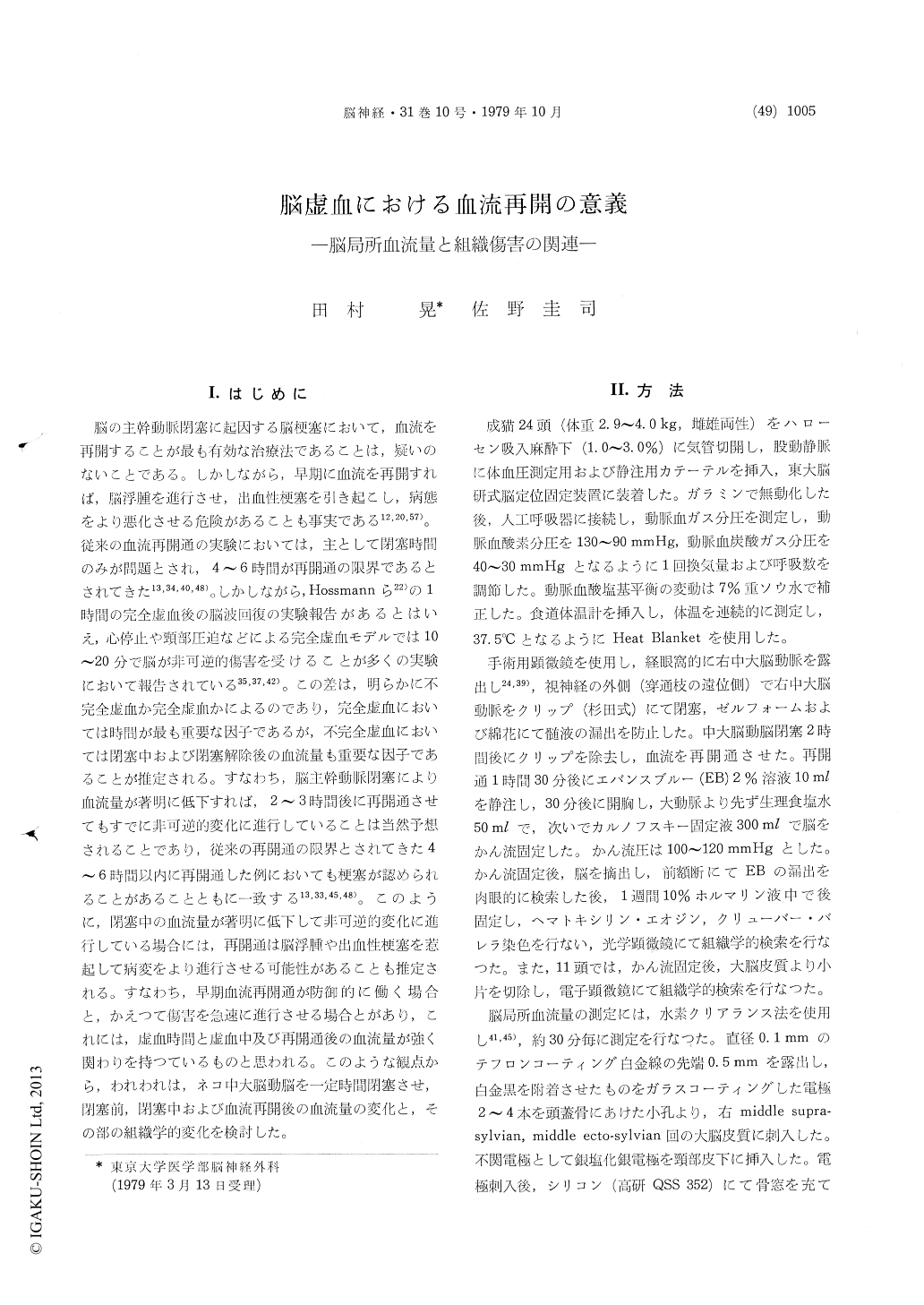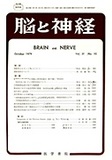Japanese
English
- 有料閲覧
- Abstract 文献概要
- 1ページ目 Look Inside
Ⅰ.はじめに
脳の主幹動脈閉塞に起因する脳梗塞において,血流を再開することが最も有効点治療法であることは,疑いのないことである。しかし点がら,早期に血流を再開すれば,脳浮腫を進行させ,出血性梗塞を引き起てし,病態をより悪化させる危険があることも事実である12,20,57)。従来の血流再開通の実験においては,主として閉塞時間のみが問題とされ,4〜6時間が再開通の限界であるとされてきた13,34,40,48)。しかしながら,Hossmannら22)の1時間の完全虚血後の脳波回復の実験報告があるとはいえ,心停止や頸部圧迫などによる完全虚血モデルでは10〜20分で脳が非可逆的傷害を受けることが多くの実験において報告されている35,37,42)。この差は,明らかに不完全虚血か完全虚血かによるのであり,完全虚血においては時間が最も重要点因子であるが,不完全虚血においては閉塞中および閉塞解除後の血流量も重要な因子であることが推定される。すなわち,脳主幹動脈閉塞により血流量が著明に低下すれば,2〜3時間後に再開通させてもすでに非可逆的変化に進行していることは当然予想されることであり,従来の再開通の限界とされてきた4〜6時間以内に再開通した例においても梗塞が認められるてとがあることともに一致する13,33,45,48)。このように,閉塞中の血流量が著明に低下して非可逆的変化に進行している場合には,再開通は脳浮腫や出血性梗塞を惹起して病変をより進行させる可能性があることも推定される。すなわち,早期血流再開通が防御的に働く場合と,かえつて傷害を急速に進行させる場合とがあり,これには,虚血時間と虚血中及び再開通後の血流量が強く関わりを持つているものと思われる。このような観点から,われわれは,ネコ中大脳動脳を一定時間閉塞させ,閉塞前,閉塞中および血流再開後の血流量の変化と,その部の組織学的変化を検討した。
The correlation between the changes of regional cerebral blood flow (rCBF) and the histological changes were examined using the middle cerebral arterial (MCA) occlusion model in cats. A total of 24 adult cats were tracheostomized and anesthe-tized by inhalation of halothane. The right MCA was clipped by the transorbital approach.
Two hours after the application, the clip was removed and the brain was recirculated for two hours. Then, the brain was perfusion-fixated and the histological studies were carried out. The animals were separated into two groups according to the severity of histological damages using light and electron microscope. Severe cortical damage was present in 8 cats (Group A). In the remaining 16 cats, little or no cortical damage was found (Group B). The averaged rCBF values before occlusion were 45. 4±2. 3 ml/100 gm/min in group A and 46.5±1. 6 in group B, showing no statisti-cally significant difference. Between these two groups, however, there was a statistically significant difference in the averaged rCBF values during the ischemic period. In group A, the averaged rCBF values during MCA occlusion was only 6. 8 + 0.9 and in group B, it was 25.3±0.8. In the recirculation period, there was a prompt and uniform recovery of rCBF in group B. Whereas in group A, a marked diversity of rCBF ranging fromoligemia to hyperemia ensued.
This is presumably a reflection of inhomogeneous blood flow, or patchy non-filling of the cerebral cortex. The critical values of rCBF as to the occurrence of severe cortical damage in two-hoursMCA occlusion is considered to lie between the lowest value of group B and the highest value of group A, i. e., around 12-15 ml/100 gm/min.

Copyright © 1979, Igaku-Shoin Ltd. All rights reserved.


